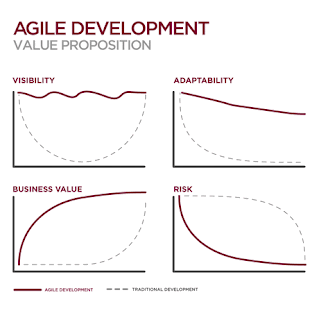What is Agile Software Development (Brief Description)

Agile software development is a conceptual framework for software engineering that promotes development iterations throughout the life-cycle of the project.
There are many agile development methods; most minimize risk by developing software in short amounts of time. Software developed during one unit of time is referred to as an iteration, which may last from one to four weeks. Each iteration is an entire software project: including planning, requirements analysis, design, coding, testing, and documentation. An iteration may not add enough functionality to warrant releasing the product to market but the goal is to have an available release (without bugs) at the end of each iteration. At the end of each iteration, the team re-evaluates project priorities.
Agile methods emphasize face-to-face communication over written documents. Most agile teams are located in a single open office sometimes referred to as a bullpen. At a minimum, this includes programmers and their "customers" (customers define the product; they may be product managers, business analysts, or the clients). The office may include testers, interaction designers, technical writers, and managers.
Agile methods also emphasize working software as the primary measure of progress. Combined with the preference for face-to-face communication, agile methods produce very little written documentation relative to other methods. This has resulted in criticism of agile methods as being undisciplined.
Agile methods grew out of the real-life project experiences of leading software professionals who had experienced the challenges and limitations of traditional waterfall development on project after project. The approach promoted by agile development is in direct response to the issue associated with traditional software development – both in terms of overall philosophy as well as specific processes.
Agile development, in its simplest form, offers a lightweight framework for helping teams, given a constantly evolving functional and technical landscape, maintain a focus on the rapid delivery of business value (i.e., “bang for the buck”). As a result of this focus and its associated benefits, organizations are capable of significantly reducing the overall risk associated with software development.
In particular, agile development accelerates the delivery of initial business value, and through a process of continuous planning and feedback, is able to ensure that value is continuing to be maximized throughout the development process. As a result of this iterative planning and feedback loop, teams are able to continuously align the delivered software with desired business needs, easily adapting to changing requirements throughout the process. By measuring and evaluating status based on the undeniable truth of working, testing software, much more accurate visibility into the actual progress of projects is available. Finally, as a result of following an agile process, at the conclusion of a project is a software system that much better addresses the business and customer needs.
The diagram below displays the differences between agile and waterfall development processes. By delivering working, tested, deployable software on an incremental basis, agile development delivers increased value, visibility, and adaptability much earlier in the life cycle, significantly reducing project risk.
 |
| Agile Development |


Thank you for sharing valuable information
ReplyDeleteSoftware testing company
Automation testing company
SAP software development company
As a software product company, Tech saga is the best Automation strategy development company in Noida and we are here to enable you to achieve the best in terms of accuracy, efficiency, and profit. Opt for our end-to-end automation solutions and enjoy key benefits comprising well-documented information, easy tracking and scheduling, less paperwork, zero data loss, less human error, faster process completion, and so on
ReplyDelete